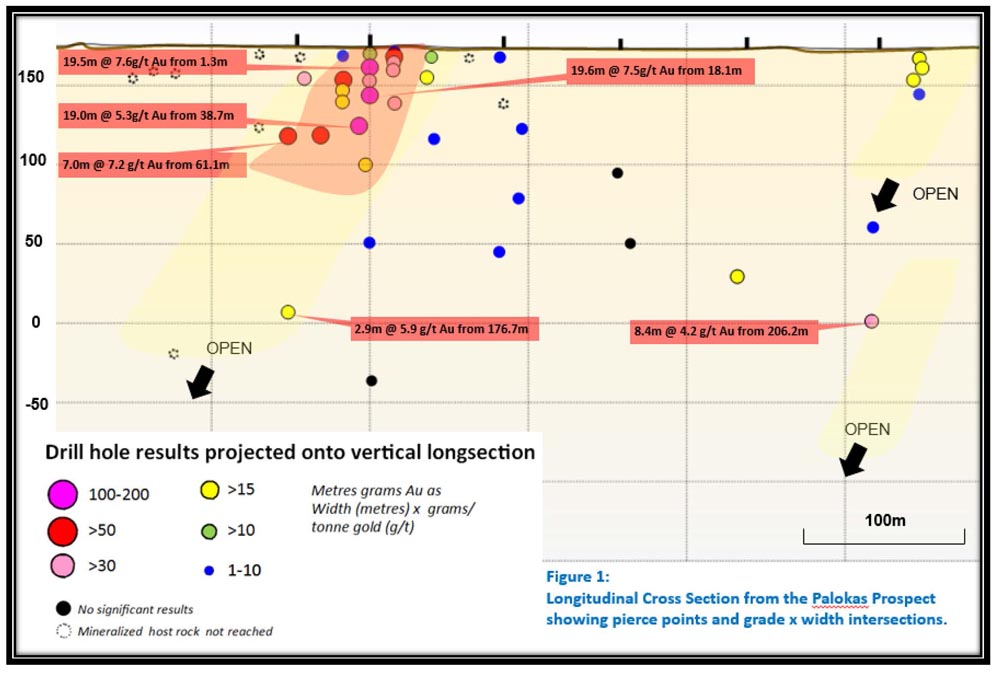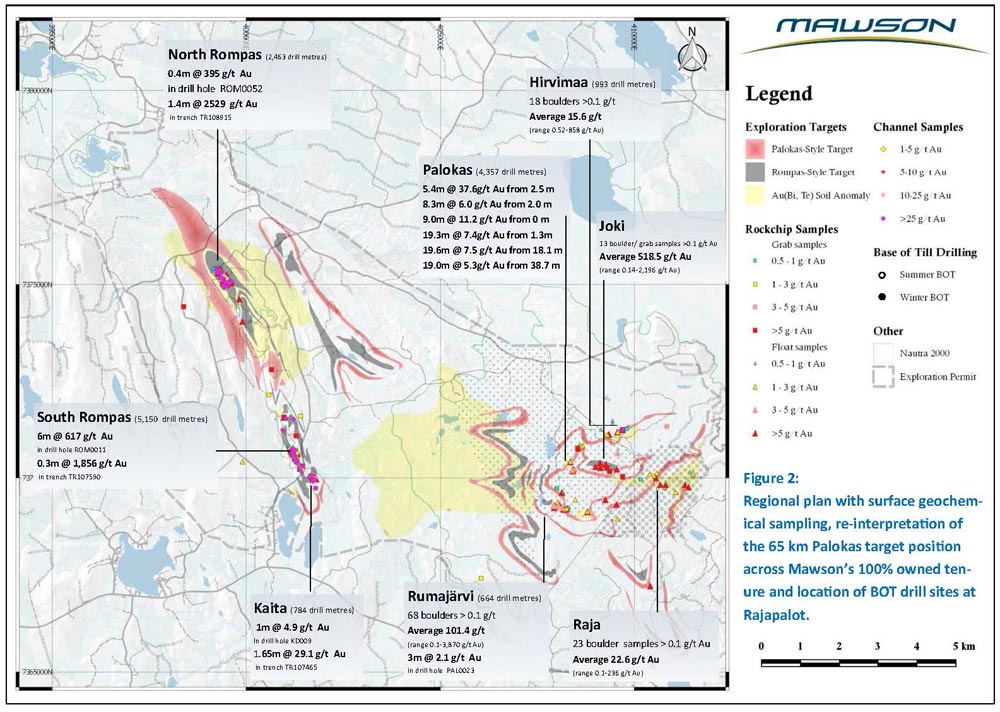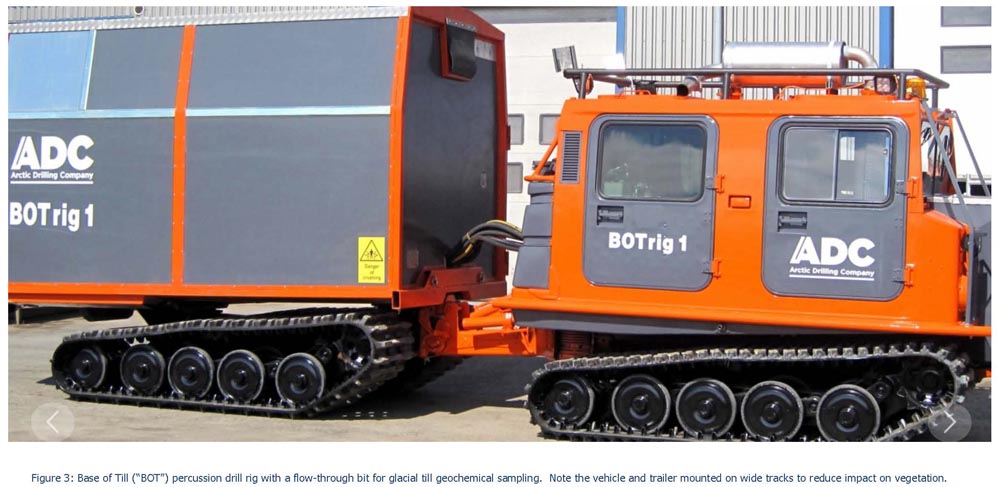Key Points:
- 1,000 base-of-till (“BOT”) drill hole program to commence at Rajapalot from August 2016;
- Landholder permit now received for commencing BOT program east of Palokas.
- Hand-portable diamond drilling, to 100 metres depth, to recommence at the Palokas gold project in August 2016;
- The results from the recently completed winter diamond drill campaign have confirmed the large scale of the gold mineralized system at Rompas-Rajapalot and redefined the mineralization style as a Paleoproterozoic Lode Gold±Ironstone-Copper Style system;
- This reinterpretation has identified 65 kilometres of gold mineralized target stratigraphy within Mawson’s exploration permit area and the BOT drill program will provide a focus on key structural-stratigraphic relationships;
- Continued baseline mapping of species, habitats and vegetation has been ongoing with up to five biologists collecting data for plants, birds and fauna for ongoing environmental studies over the last 8 weeks.
The recently completed 16 hole winter diamond drill campaign for 3,386 metres was encouraging in that it confirmed the large scale of the gold mineralized system at Rompas-Rajapalot (Mawson New Release April 26, 2016). The campaign included 8.4 metres @ 4.2 g/t gold from 206.0 metres in PAL0016, including 3.4 metres @ 9.5 g/t gold from 211 metres, below and 450 metres along strike from earlier near-surface drill results which included 19.6m @ 7.5 g/t gold from 18.1 metres in drill hole PRAJ0107 including 5.0m @ 24.1 g/t gold from 26.7 metres (Figure 1 — Longitudinal Section).
With the current permits that the Company now has obtained, a large and systematic semi-regional exploration program is warranted to test the larger mineralized area which is covered by up to 99% thin glacial soils, which average 3-5 metres thickness over the entire project area. The reinterpretation of the geology after winter drilling indicates that more than 65 kilometres of host stratigraphy exists within Mawson’s permit area (Figure 2 — Regional Plan).
The exploration program for the remainder of 2016 will consist of:
- Three hundred BOT drill holes at Raja (Figure 2). Drilling will commence at the start of August 2016. The area is located outside Natura 2000 areas, to the east of Palokas. Drillling will take place on a 150 metre grid, with infill drilling at closer spacing based on onsite hand-held XRF analysis and geological logging. This drilling will take place on both Mawson’s recently granted exploration permit at Hirvimaa, as well as within an area covered by a landholder permit, received last week. Multiple surface targets remain untested, which include:
- Raja, located 500 metres east of Joki, where 23 boulders and subcrops extend over 1,500 metres and using a >0.1 g/t gold lower cut, range from 0.1 g/t gold to 236 g/t gold with an average of 22.6 g/t gold and median of 1.0 g/t gold. This area is interpreted as the extension of the Palokas mineralized zone.
- Light-weight, hand-portable “Winkie” diamond drilling down to 100 metres depth, will recommence from late August 2016 at Rajapalot, to test near surface drill targets;
- Field mapping continues within the new target areas;
- Seven hundred BOT drill holes to be drilled at Rajapalot, to aid in targeting gold at the Palokas prospect. This program is subject to final permitting and inside Natura 2000 areas and will commence when frozen ground conditions allow for access from December 2016. The Palokas mineralized position will be systematically tested over 3.5 kilometres strike. Multiple surface geochemical targets remain untested, which include:
- Rumajärvi, located 1,500 metres south of Palokas, where 68 boulders and subcrops >0.1 g/t gold range from 0.11 g/t gold to 3,870 g/t gold with an average of 101.4 g/t gold and median of 0.6 g/t gold. Two holes drilled at Rumajärvi failed to find the source of the boulder train.
- Joki, which was not tested during this drill campaign, where 13 boulders and outcrops >0.1 g/t gold range from 0.10 g/t gold to 2,871 g/t gold with an average of 518.5 g/t gold and median of 135.5 g/t gold.
- Boardwalk, which was not tested during this drill campaign, where 13 boulders and outcrops >0.1 g/t gold range from 0.18 g/t gold to 221 g/t gold with an average of 38.2g/t gold and median of 1.0 g/t gold.
- Larger scale drilling, subject to final permitting and when the ground freezes, from December 2016 to follow up on near surface and the larger scale and systematic BOT drilling programs.
- Continued baseline mapping of species, habitats and vegetation. Up to five biologists have been collecting baseline data for plants, birds and fauna for ongoing environmental studies over the last 8 weeks. After 2 years of detailed biological studies, the Company is now well positioned to complete Natura Assessment for the entire 16,380 hectares of granted exploration permits and application areas.
Base of Till (“BOT”) Drilling
Various sampling methods are available for testing bedrock and dispersion of gold below glacial till. The method is dictated by the scale and objective of the geochemical survey. Mawson has chosen a 150 metre spaced local grid sampling survey, with the main goal is to map both the gold distribution and the associated geochemical signature of the hydrothermal alteration to define deeper drill targets, beneath an area that is 99% covered by 3-5 metres of glacial soils. A small, tracked percussion drill rig, with a flow-through bit, will drill through the glacial till and sample the till-bedrock interface (Figure 3).
Rompas-Rajapalot Global Analogues
As a result of the first deep diamond drilling program over the last winter, Mawson has been able to define the Rompas-Rajapalot mineralization as a Paleoproterozoic Lode Gold±Ironstone-Copper system. This well-documented deposit style has contributed more than 200 million ounces of gold at a global scale. The best analogue to Palokas is the Homestake Mine in South Dakota. However, Salobo (Brazil), and the Tanami mines in Australia are also regarded as excellent analogues.
The similarities of Rompas-Rajapalot to the Paleoproterozoic Lode Gold±Ironstone-Copper deposit style include:
- Similar age host rocks and mineralization age;
- A similar tectonostratigraphic setting with a Paleoproterozoic sequence with large layered mafic sequence at the base, mature clastic and carbonate platform sediments, including rocks deposited during the Great Oxidation Event (GOE) transitional into deeper water, reduced facies including carbonaceous rocks.
- Post-peak metamorphic emplacement of large intrusives driving hydrothermal fluids causing metal deposition in a brittle and brittle-ductile regime.
- A strong stratigraphic-structural control including stratabound and fold hinge related mineralization;
- Large retrograde hydrothermal fluid systems carrying significant gold;
- Similar iron and magnesium-rich alteration rock types forming a close association with gold mineralization.
The Rompas-Rajapalot project continues to evolve with significant advances in the understanding of similar structural-stratigraphic and fluid-rock controls on apparently contrasting mineralization styles. The adoption of a “mineral systems” approach combined with the results of the recent winter diamond drilling allows us to interpret the entire new mineralized gold camp that Mawson has defined. This new interpretation has led to the definition of more than 65 kilometres of host stratigraphy in the project area. The Paleoproterozoic Lode Gold±Ironstone-Copper target style is a geological concept and is not necessarily indicative of the mineralization style that will eventually exist on the Property. The exploration programs defined for the rest of 2016 will systematically test some of the target areas, in order to test structural and stratigraphic traps that may host this style of gold mineralization.
Technical and Environmental Background
The qualified person for Mawson’s Finnish projects, Mr Michael Hudson, President & CEO for Mawson and Fellow of the Australasian Institute of Mining Metallurgy has reviewed and verified the contents of this release.
Two Energold Group (“Energold) EGD Series III rigs which have been modified to meet environmental requirements and climate conditions were used for the recent winter drill program. Core diameter was NTW (56 mm) diameter core. Core recoveries were excellent and average close to 100% in fresh rock. After photographing and logging, core intervals averaging 1 metre in length for mineralized samples and 2 metres for barren samples were cut in half at the Geological Survey of Finland (GTK) core facilities in Rovaniemi, Finland. The remaining half core is retained on site for verification and reference purposes. Analytical samples were transported by Mawson personnel or commercial transport from site to the CRS Limited facility in Kempele, Finland. Samples were prepared at Kempele and analyzed for gold at Raahe using the PAL1000 technique which involves grinding the sample in steel pots with abrasive media in the presence of cyanide, followed by measuring the gold in solution with flame AAS equipment. The QA/QC program of Mawson consists of the systematic insertion of certified standards of known gold content, and blanks at the within interpreted mineralized rock. In addition, CRS inserts a number of blanks and standards into the analytical process. Read the press release here.
Timeline
See how VTEM technology mapped the Palokas Prospect:
Mawson drill update at Palokas gold project in Finland 24 February 2016
Mawson’s Kaita Gold Discovery & Exploration Update from Rompas, Finland 26 June 2013


